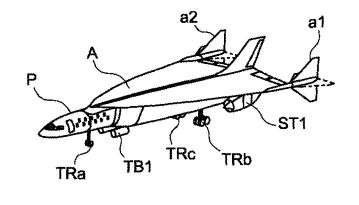August 6, 2015 weblog
Ultra-rapid air vehicle proposed in Airbus patent

Two inventors have had a vision of a hypersonic rocket-powered jetliner. A 17-page patent document has described that vision, titled "Ultra-rapid air vehicle and related method for aerial locomotion." Inventors are listed as Marco Prampolini and Yohann Coraboeuf.
Assignees were listed as European Aeronautic Defence and Space Company (EADS), France and Astrium SAS. (Aviation Week reported in 2013 that EADS decided to make significant corporate structure changes and placed the company under the Airbus brand.)
The patent involves a point to point ultra-rapid air vehicle, something that stands out from the CONCORDE and the Tupolev Tu-144, both of which are supersonic. Our ultra-fast vehicle, they said, enables the performance of both these aircraft to be improved "very considerably."
Popular Science listed the features of their invention: It is a plane powered by turbojets, ramjets, and a rocket.
The two ram-jets are under its delta wings, and a pair of Turbo-jets are under the fuselage. A rocket engine is at the rear end of the fuselage, said PatentYogi.
These help to propel 2 or 3 tons of cargo, or 20 passengers, at speeds of up to Mach 4.5 over roughly 5,600 miles in three hours.
The inventors notably addressed the sound hurdle. Their proposed vehicle substantially reduces the noise when the sound barrier is broken. "The hypersonic Airbus makes the leap from subsonic to supersonic speeds vertically, while climbing like a rocket, which should dissipate the sound before it reaches the ground," said Kelsey Atherton in Popular Science.
PatentYogi said the patent suggests a revolutionary aircraft "that leaves every other supersonic jet far behind." After all, a cruising speed of Mach 4.5 puts "even the fastest Concorde to shame," he said. "At 4.5 mach, you can reach from London to NY in one hour. Currently it takes a seven-hours flight."
Deepak Gupta, founder of PatentYogi, helped to analyze what is behind the concept's higher supersonic speeds. Once the aircraft climbs to a certain altitude, turbo-jets are retracted into the fuselage. The rocket engine is ignited at full power. This makes the aircraft travel vertically like a rocket, at supersonic speeds. With the vertical trajectory, the energy of the supersonic boom is dissipated in all horizontal radial directions and does not encounter the ground.
He said ingenuity lies in the pair of fins situated on the outer ends of the delta wings. "At speeds less than MACH 1, these fins are oriented horizontally. However, once the speed exceeds MACH 1, the fins are oriented vertically. This causes the center of pressure to be maintained at the same point and thus providing greater stability. After reaching a very high altitude, the aircraft curves into a horizontal trajectory at which point the rocket engine is powered off and closed by a door to make it streamlined. The ram jets are then ignited and the aircraft is propelled horizontally at supersonic speeds."
Commented Jane Wakefield, technology reporter, BBC: "A vast number of patent applications don't ever see the light of day as real products although technology described in it may find its way into some Airbus products."
More information: Patent
© 2015 Tech Xplore




















